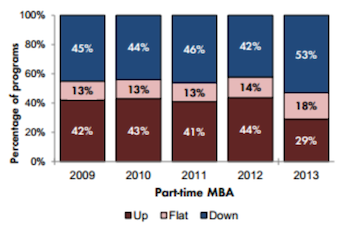Where’s the bottom?
Applicants and enrollment in the largest segment of the MBA market–those evening part-time programs that allow students to juggle work and study–have been falling for several years. And the decline seems to be accelerating to levels that have deans worried.
More than half of part-time programs reported a decline in applications in 2013, the largest percentage showing downturns in five years, according to data from the Graduate Management Admission Council. Some 53% of the business schools said part-time applications were down, compared to 42% a year earlier and 45% in 2009. The smallest percentage in five years–just 29%–reported that their apps were up. That’s a big drop from the previous year when 44% saw some increase.
Surveys of prospective MBA students show that things aren’t expected to improve anytime soon. In fact, the trend line is cause for even more worry and concern. In 2009, 39% of prospects of MBA prospects were interested in a part-time degree, that number fell six percentage points to 33% in 2013, according to a 2014 GMAC survey.
“We keep hoping to find a bottom,” says Phil Miller, assistant dean of MBA programs at the University of Minnesota’s Carlson School of Management. “I would say this is it, but this year we continue to be down from last year, and last year we’re down from the year before.”
The latest numbers from the Association to Advance Collegiate Schools of Business (AACSB) confirms what individual schools have been reporting. Part-time MBA enrollment in 126 AACSB member schools in North America has fallen by 13.6% in the past five years to 26,077 in 2012-2013 from 30,194 in 2008-2009. Of course, full-time enrollment is also down, but not nearly as much—a slight 2.0% drop in the past five years.
The cause of the dip is hard to pinpoint. Business schools blame it on everything from an uncertain economy and crushing undergraduate debt to the proliferation of online MBA degree programs at ranked business schools. Richard Lyons, dean of UC-Berkeley’s Haas School of Business, attributes it to an increasing array of free online MOOC courses and degrees. “It’s getting potential students saying, ‘If I can get big chunks of that for free, I’ll try it out.’ That is having a transitory effect on part-time programs because people now want to wait-and-see how it works. At the edges, programs that are offering more flexible formats are starting to pull people away.”
Schools Reporting Change In Application Volume
For many business schools, this is disastrous news. Because of their popularity, part-time MBA programs are among the most lucrative revenue generators for universities. The courses are often taught by a healthy number of adjunct faculty who aren’t paid nearly as much as the tenure-track professors. So the returns on such programs can be significant.
And for students, these programs offer the ultimate flexibility to attend school while still holding down a job and some semblance of a personal life. Part-time MBAs can often stretch out the course requirements over several years, turning up the dial when they have more free time and turning it down when professional and personal issues intervene. That flexibility had made enrollment in part-time programs the single biggest group of students studying for an MBA degree.
Part-Time MBA Enrollment Declining Much Faster Than Full-Time In North America
| School Year | Part-Time Enrollment | Full-Time Enrollment |
|---|---|---|
| 2008-2009 | 23,334 | 10,143 |
| 2009-2010 | 22,068 | 10,178 |
| 2010-2011 | 23,513 | 10,763 |
| 2011-2012 | 21,334 | 10,128 |
| 2012-2013 | 19,776 | 9,937 |
Source: AACSB data from 94 member schools in the U.S. and Canada reporting all five years
Poets&Quants contacted several top schools for their take on the contributing factors and how they’re responding. Here’s what we found:







Questions about this article? Email us or leave a comment below.